Listen to my last vlog post posted below to see how I reflect on what I have learned this semester about the critical issues in education! I enjoyed working with you all this semester and wish you the best of luck throughout the rest of your time at Molloy and in your future!
Beyond the Classroom Walls: Building Stronger Home-School Relationships
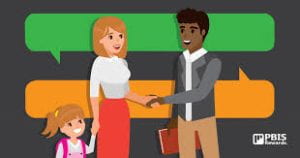 https://www.pbisrewards.com/blog/improving-parent-teacher-communication/%5B/caption%5D
https://www.pbisrewards.com/blog/improving-parent-teacher-communication/%5B/caption%5D
Part 1:
Home/school connections are beyond an occasional parent-teacher meeting or report card sent home in the student’s backpack. Having and maintaining a good home/school connection between the families and teachers promotes a healthier learning and growth environment. Some ways in which this can be done are having effective communication and involving the families in school activities. By embracing a culture of inclusivity, transparency, and mutual respect, teachers and families can create a supportive environment for the students.
Borovoy (2016) describes many ideas for teachers and parents to connect and engage throughout the school year. This article shows multiple important factors along the lines of how parents can get involved, how to effectively communicate, and strategies, and tips for teachers with communicating with families.
Aguilar (2011) gives twenty tips for developing positive relationships with parents. It’s important to have good facial expressions, know their names, communicate often, ask questions, and listen! This will maintain a positive and healthy relationship between the teachers and families. By doing so, the students will have a better learning experience and feel more supported by their family and their teachers. This article would be beneficial for teachers to read over to be more confident in themselves before communicating to their student’s families.
Lastly, Breiseth (2021) is an important read since it includes ELL families. Communicating with ELL families can be a struggle but this article gives 10 strategies on how to make it easier for both the teacher and families. Communicating can be extremely challenging and has many responsibilities that come with it so learning how the families prefer to communicate and actively engaging in resources can make the entire process a lot easier. Breiseth (2021) stated that school districts are legally required to provide information in families’ home languages and that translators have multiple options. This is beneficial to know since these rules and regulations can ease any stress and anxiety about communicating with the families and faculty members.
One film we watched was The 5-Minute Film Festival: Parent-Teacher Partnerships showed a video of 300 parents receiving diplomas and being alongside teachers in the classrooms as parent mentors. The idea of parents assisting in the classrooms could be beneficial to have an extra set of eyes in the classroom, build relationships with everyone in the school, and help the teachers in the classrooms. I believe there could be some downside to this idea if a child becomes too attached to their parent or another child gets discouraged if their parent isn’t able to come into the class. It has many positive and negative aspects behind it but it could be a great idea to at least try!
Another film we watched was 9 Ways to Communicate with Parents for Teachers/Increase Parent Communication! This video gave many tips and strategies for communicating with parents in a timely matter. As stated earlier, improving your relationships with students’ parents can lead to students being more successful in the classroom! It’s important to acknowledge that not every strategy will work for every teacher or parent so it’s important to not be discouraged by it and change things up until you find what works best for both the parents and teachers!
For this week’s blog, we had the opportunity to attend a Board of Education Meeting. I attended the Bellmore-Merrick School District Board of Education Meeting on March 6, 2024. Going into it, I honestly thought it was going to be very boring but I was actually very engaged and interested the entire time. I even told my mom about it and said I wanted to go to another one! Throughout the meeting, the dean acknowledged every school in the district and many of their accomplishments from the last meeting to this one including the increase in the number of clubs, and how well all of the sports teams were doing. There was even a presentation from a group of faculty members describing their new club that had just begun where students can meet once a month and talk with other students, do activities, and meet new people. I found this to be a great program for students who may be shy or have a hard time making friends. Another event that happened during this meeting was all the families that came to support the holiday of Eid. They stated they have been coming for years and fighting for more days off for the students to celebrate their culture and holiday with their families without missing days of school. I found this very interesting since they listed many points as to why they have been and still are coming and fighting for this and curious as to why it hasn’t happened yet. I realized having that many days off may throw off the school calendar greatly and would need to redo it to make these families happy. Overall, it was a very interesting meeting and I would want to attend more in the future!
Part 2:
Communicating effectively with families is crucial for any teacher no matter what grade level and throughout the entire school year. There are many ways I intend to communicate with the families of my future students. I hope to become a kindergarten special education teacher so I feel like a welcome letter before the first day of school would be the first priority. This is a huge milestone for children and their families so introducing myself, sharing my background, and expressing my enthusiasm for working with the students is not only beneficial but could ease any anxiety for the families.
Throughout the school year, I would also plan parent-teacher conferences to discuss the child’s progress, strengths, and areas for improvement. In addition, I would set up a folder and include all of these aspects on written paper for the child to take home to their family. This makes it easier for the parent to be up to date with their child’s achievements or any challenges they may be facing. This is also extremely important, especially for special ed students, since it can all be documented and shared between the parents and teachers daily.
I would also be mindful of diverse communication needs within families, such as language barriers or disabilities, and ensure that any information is communicated in a way that is accessible to all parents. This could involve translators, visual aids, or alternate formats for communication. Breiseth (2021) is an important article to re-read since it includes ELL families and strategies for effective communication between teachers and families with a language barrier!
Lastly, I believe in “Open Door Policies” and will encourage the families to reach out with any questions, concerns, or ideas they may have about their child’s education. This can build trust and collaboration between the parents and teachers as well as give the child the best and most supportive education they can possibly get!
 https://twitter.com/artteacherjoys/status/1184712453738729472%5B/caption%5D
https://twitter.com/artteacherjoys/status/1184712453738729472%5B/caption%5D
References:
Aguilar, E. (2011, September 23). 20 Tips for Developing Positive Relationships with Parents. Edutopia. https://www.edutopia.org/blog/20-tips-developing-positive-relationships-parents-elena-aguilarLinks to an external site.
Borovoy, A.E. (2012, November 2). 5-Minute Film Festival: Parent-Teacher Partnerships. Edutopia. https://www.edutopia.org/blog/film-festival-parent-teacher-partnerships
Breiseth, L. (2021, August). Communicating with ELL Families: 10 Strategies for Schools. National Education Association. https://www.nea.org/professional-excellence/student-engagement/tools-tips/communicating-ell-families-10-strategiesLinks to an external site.
Family Engagement: Resource Roundup (2010, July 14). Edutopia. https://www.edutopia.org/home-school-connections-resourcesLinks to an external site.
Vestal’s 21st Centory Classroom (2021, August 22). 9 Ways to Communicate with Parents for Teachers // INCREASE Parent Communication!
. YouTube. https://youtu.be/8aHJkRXgbcE
Beyond the Blackboard: How Technology is Transforming Education
 https://onlinelearningconsortium.org/8-things-you-should-know-before-using-social-media-in-your-course/%5B/caption%5D
https://onlinelearningconsortium.org/8-things-you-should-know-before-using-social-media-in-your-course/%5B/caption%5D
Social media use in general and the use of cell phones and technology in schools have been debated greatly. Some believe that social media and technology use is destroying our society while others acknowledge the clear benefits to us personally and our community.
While I acknowledge the benefits of incorporating technology and social media into schools, I believe it must be done thoughtfully and responsibly. It’s important to have a balance between using technology to enhance learning opportunities while reducing its potential negative impacts on students’ well-being and academic performance. Schools should prioritize digital literacy education, promote responsible technology use, and provide support for students to navigate the challenges posed by social media and technology. Additionally, efforts should be made to address any obstacles in accessing technology to ensure that all students can benefit from its educational opportunities.
 https://www.platinumseoservices.com.au/blog/pros-and-cons-of-seo/%5B/caption%5D
https://www.platinumseoservices.com.au/blog/pros-and-cons-of-seo/%5B/caption%5D
The documentary Plugged In: The True Toxicity of Social Media, delves into the impact of technology and social media on students. The documentary features interviews with students from Liverpool University where they discussed how they felt about social media and their experience with it. Hearing directly from these students provides insights into the challenges they may face navigating the digital world. One example from one of the students was from someone who was trans being bullied online in their comments. This led to not actual violence between students, but more emotional and psychological violence for the student themself.
Another story from the documentary was the point of view from Ronan Parke who was a Britain’s Got Talent Runner Up in 2011. His story shows how social media and technology can affect everyone, even little kids who are going on a show to express their talent. Parke explained how because of his gain of popularity, he had to get all of these social media apps at the age of 12 and have them be public, official accounts. This opened the doors to everyone’s opinion which he wasn’t prepared for and really opened his eyes. From this story, what stuck out to me the most was how one of the narrators kept saying “We feel invisible.” This carries a very heavy meaning as it shows the experience of students navigating through technology and social media.
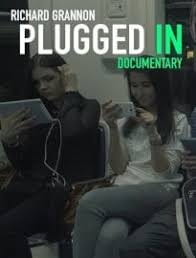 https://topdocumentaryfilms.com/plugged-in-true-toxicity-social-media-revealed/%5B/caption%5D
https://topdocumentaryfilms.com/plugged-in-true-toxicity-social-media-revealed/%5B/caption%5D
The article The Scientific Debate Over Teens, Screens and Mental Health describes the negative impacts technology and social media have on students and faculty members in the school community. According to Kamenetz (2019), while schools need to monitor what students do on the internet, there can still be negative effects on students. For example, suicide and anxiety rates are increasing, mental health is decreasing, and more parents are becoming concerned about teen tech addiction.
On the other hand, the article Schools Say No to Cellphones in Class. But Is It a Smart Move? highlights both arguments as to whether or not schools should ban cell phones in classrooms. Some argue that it is a distraction, disruption, and misuse by students such as cheating, cyberbullying, and accessing inappropriate content. Some argue that cell phones are valuable educational tools when used appropriately. For example, educational apps, resources, and research opportunities are great tools students should have access to to increase their academic insights.
“The COVID-19 pandemic is quickly demonstrating why online education should be a vital part of teaching and learning” (School of Education, 2020). This sentence from the article How Important Is Technology in Education? Benefits, Challenges, and Impact on Students shows how without technology, learning and teaching would not be possible during quarantine. Other than the pandemic, there are still many beneficial ways in which technology and the use of the Internet in schools affect students and everyone in the education system. For example, technology is becoming more popular every day and the use of it in schools will only improve student performance by providing easy-to-access information, accelerated learning, and fun opportunities to practice what they learn (School of Education, 2020). With it being monitored by schools, and the use of the internet responsibly, it will also increase collaboration and communication among students, teachers, families, and faculty members.
In conclusion, technology and social media have both positive and negative impacts on students and how it affects them, but with it growing more and more each day, it is important to implement technology and the internet into schools.
Resources:
How important is technology in education?: American University. School of Education Online. (2023, April 17). https://soeonline.american.edu/blog/technology-in-education/
Kamenetz, A. (2019, August 27). The scientific debate over teens, screens and Mental Health. NPR. https://www.npr.org/2019/08/27/754362629/the-scientific-debate-over-teens-screens-and-mental-health?utm_source=npr_newsletter&utm_medium=email&utm_content=20190901&utm_campaign=ed&utm_term=nprnews&utm_id=25646263
Klein, A. (2024, April 2). Schools say no to cellphones in class. but is it a smart move?. Education Week. https://www.edweek.org/technology/schools-say-no-to-cellphones-in-class-but-is-it-a-smart-move/2019/09
YouTube. (2019b, January 23). Plugged in : The true toxicity of social media revealed (Mental Health Documentary). YouTube. https://www.youtube.com/watch?v=PHzwMLx-rKc
Exploring Lesson 3: Drugs and The YOU-Th Brain

https://med.stanford.edu/halpern-felsher-reach-lab/preventions-interventions/Safety-First/safety-first-lesson-3.html
In this blog post, I want to talk about Lesson 3 from Stanford Medicine’s Safety First program. This lesson is all about how unique everyone’s brains are and how drugs affect the brain, especially during development.
This lesson begins by describing the learning objectives and standards of the National Heath Education. When scrolling down, it presents a slideshow that explains important key terms, examples of how everyone’s brain is unique, and how drugs affect the brain. The presentation gave many important examples, especially highlighting how drugs affect the brain during its development stages.
I appreciated how this lesson was presented in a clear and accessible manner. The language shown was straightforward, and the provided examples were simple. Additionally, valuable advice and information about the brain were offered regarding staying away from substance abuse, your brains job, and what happens during withdrawals.
Another thing I liked about this slideshow was the fun fact slides and the exit ticket. I believe that answering an exit ticket at the end of every lesson gives everyone a better understanding of what they just learned, and how they can apply that information to different questions being asked. For example, this lessons exit ticket question was “Why is it so important to protect your brain during adolescence and development?” I feel like this makes you think further beyond what you learned and how you could apply maybe personal experiences it into this question. I also liked the Kahoot attached to it. Kahoot is a fun way to quiz students and see how much knowledge they understood from the lesson! I would definitely want to use Kahoot in my future classrooms.
I also really like how much material this lesson gives for teachers or anyone wanting to learn more about this subject. For example, it shows talking points associated with a slide chart as well as a discussion guide for this lesson. This is useful to make sure you’ve hit every point the lesson is trying to give and ways to discuss this topic with other peers.
In conclusion, I really enjoyed this lesson and feel like it teaches anyone about your brain, what drugs can do to your brain, and the negative impacts overall. I feel like this lesson can definitely be used in my future classrooms since it gives a well presented slideshow with examples and questions to ask my future students to expand their thinking and cover what they have learned.
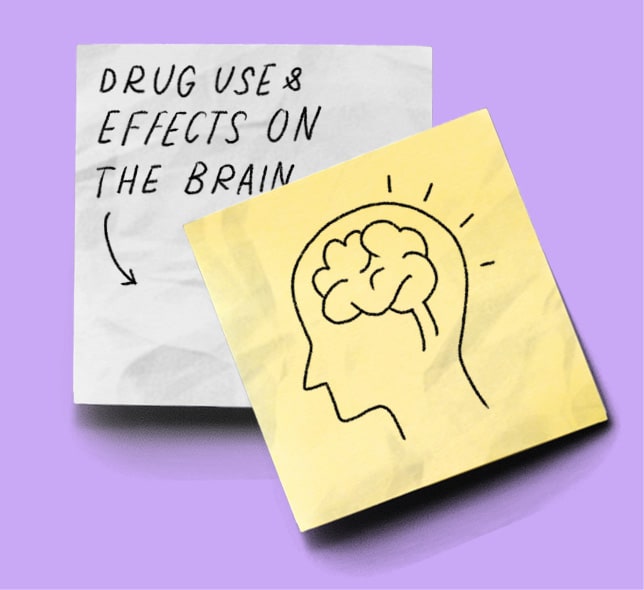
References:
Halpern-Felsher REACH Lab. (n.d.). Safety First – Lesson 3. https://med.stanford.edu/halpern-felsher-reach-lab/preventions-interventions/Safety-First/safety-first-lesson-3.html
Social Emotional and Mindfulness are important components of education because they contribute significantly to the overall well-being and success of students, teachers, and other faculty members of the school’s community. Integrating social-emotional learning and mindfulness into the school curriculum fosters a holistic approach to education that prioritizes the well-being and development of the student, setting them up for success both academically and in life. Listen to my vlog posted below to learn more!
Name: Kaylee Schwenk
Partner: Nallely Vargas Linares
| Data Points |
Community 1
Bellmore-Merrick |
| Number of Students |
5,141 |
| Financial Transparency |
District / District of Location: $27, 744.00
County Average:
$27,729.77
Statewide Average:
$25, 870.33 |
| Class Size |
Average: 21 |
| 4 Year Graduation Rate |
96% |
| Standardized Test Scores |
Grade 7 ELA – 58%
Grade 8 ELA – 64%
Grade 7 Math – 63%
Grade 8 Math – 24% |
| Accountability Status |
TSI/Target |
| Per Pupil Spending |
$27,744 |
| Ethnicity |
White – 40.5%
Black – 15.8%
Hispanic – 29.5%
Asian – 10.3%
Multiracial – 3.3%
American Indian / Alaska Native – 0.7% |
| Absenteeism Rate |
Grades 1-8 – 13.5%
High School – 15.3% |
| Gender |
Male – 51%
Female – 49%
Non-Binary – 0% |
| Students with Disabilities |
890
17% |
Site Used: https://data.nysed.gov
Invisible Struggles: Addressing Poverty and Homelessness in Schools
Poverty and homelessness in schools are complex issues that can have profound impacts on students’ academic performance, emotional well-being, and their overall path in life. When students lack stable housing or live in poverty, they face numerous challenges that can impede their ability to succeed in school.
 https://ny.pbslearningmedia.org[/caption%5D
https://ny.pbslearningmedia.org[/caption%5D
After watching “The Homestretch” and reading the articles provided in the module, two themes that are shown in all of these is resilience. Resilience is shown as the students navigate the complexities of poverty and homelessness while trying to graduate and pursue their goals in life. Resilience is a main theme in all of these texts since it is shown through various behaviors, attitudes, and achievements despite facing significant challenges related to housing instability.
In the documentary “The Homestretch”, the statement “homeless is a situation, it’s not who you are” emphasizes the idea that homelessness is a temporary circumstance that someone may experience, but it does not define their identity or worth as a person. It reminds us to view individuals experiencing homelessness with empathy, understanding, and a recognition of their inherent humanity and potential for positive change. It encourages us to address homelessness as a societal issue while also respecting the dignity and worth of each person affected by it.
Another theme shown in the documentary and the readings is hope. All of the community and support services that are provided for them allow them to have this space to communicate and be there for each other during these difficult times. The documentary “The Homestretch” shows an emergency youth shelter where individuals can go and shower, do laundry, eat a meal, and sleep. Emergency youth shelters play a crucial role in addressing the immediate needs of homeless young people while also offering comprehensive support services to help them rebuild their lives and move towards a brighter future. Since some of the articles show charts and graphs of how homelessness and poverty are unfortunately increasing, it is important that as a community and society, fund and advocate for these individuals and make plans to build and create more of these shelters.
One song that can connect to the themes shown in the film and readings is “Fast Car” by Tracy Chapman. This song addresses the themes of poverty, struggle, and the desire for a better life. The narrative of the song revolves around a young woman who dreams of escaping her difficult circumstances in her fast car representing the desire to escape poverty. It emphasizes the importance of home and perseverance.
 https://www.bing.com/images/search?view=detailV2&ccid=vCyZkhDk&id=FBF6940876DE8D75564E2F55E70044A472158AC3&thid=OIF.Y78RHkrdZymHOgUWmGvdTw&mediaurl=https%3a%2f%2ftimesgo24.com%2fwp-content%2fuploads%2f2024%2f02%2fimage-305.png&cdnurl=https%3a%2f%2fth.bing.com%2fth%2fid%2fR.bc2c999210e45c228ae7f69c10c8931c%3frik%3d%26pid%3dImgRaw%26r%3d0&exph=315&expw=474&q=fast+car+tracy+chapman&simid=281807334813&FORM=IRPRST&ck=63BF111E4ADD6729873A0516986BDD4F&selectedIndex=2&itb=0&ajaxhist=0&ajaxserp=0%5B/caption%5D
https://www.bing.com/images/search?view=detailV2&ccid=vCyZkhDk&id=FBF6940876DE8D75564E2F55E70044A472158AC3&thid=OIF.Y78RHkrdZymHOgUWmGvdTw&mediaurl=https%3a%2f%2ftimesgo24.com%2fwp-content%2fuploads%2f2024%2f02%2fimage-305.png&cdnurl=https%3a%2f%2fth.bing.com%2fth%2fid%2fR.bc2c999210e45c228ae7f69c10c8931c%3frik%3d%26pid%3dImgRaw%26r%3d0&exph=315&expw=474&q=fast+car+tracy+chapman&simid=281807334813&FORM=IRPRST&ck=63BF111E4ADD6729873A0516986BDD4F&selectedIndex=2&itb=0&ajaxhist=0&ajaxserp=0%5B/caption%5D
One book that can connect to the themes shown in the film and readings is “Fly Away Home” by Eve Bunting. This book tells the story of a young boy and his father who live in an airport terminal. Readers gain insight into the challenges faced by families experiencing poverty and homelessness and the importance of hope and resilience.
 https://www.bing.com/images/search?view=detailV2&ccid=OceGM1wI&id=6EE40CA62F3B7D9C22D97A484D995FCE51B51650&thid=OIP.OceGM1wIy5qpx7YrtFvbTAHaHY&mediaurl=https%3a%2f%2fth.bing.com%2fth%2fid%2fR.39c786335c08cb9aa9c7b62bb45bdb4c%3frik%3dUBa1Uc5fmU1Ieg%26riu%3dhttp%253a%252f%252fprodimage.images-bn.com%252fpimages%252f9780395664155_p0_v1_s1200x630.jpg%26ehk%3dQYUVxVRBRyyVBNse%252bxEnxSLTDXTYfMXgjdsnZFFtROw%253d%26risl%3d%26pid%3dImgRaw%26r%3d0&exph=630&expw=632&q=%22Fly+Away+Home%22+by+Eve+Bunting%2c+illustrated+by+Ronald+Himler%3a&simid=608010225522135047&FORM=IRPRST&ck=4861E961B653A97610AB7765A4848001&selectedIndex=0&itb=0&ajaxhist=0&ajaxserp=0%5B/caption%5D
https://www.bing.com/images/search?view=detailV2&ccid=OceGM1wI&id=6EE40CA62F3B7D9C22D97A484D995FCE51B51650&thid=OIP.OceGM1wIy5qpx7YrtFvbTAHaHY&mediaurl=https%3a%2f%2fth.bing.com%2fth%2fid%2fR.39c786335c08cb9aa9c7b62bb45bdb4c%3frik%3dUBa1Uc5fmU1Ieg%26riu%3dhttp%253a%252f%252fprodimage.images-bn.com%252fpimages%252f9780395664155_p0_v1_s1200x630.jpg%26ehk%3dQYUVxVRBRyyVBNse%252bxEnxSLTDXTYfMXgjdsnZFFtROw%253d%26risl%3d%26pid%3dImgRaw%26r%3d0&exph=630&expw=632&q=%22Fly+Away+Home%22+by+Eve+Bunting%2c+illustrated+by+Ronald+Himler%3a&simid=608010225522135047&FORM=IRPRST&ck=4861E961B653A97610AB7765A4848001&selectedIndex=0&itb=0&ajaxhist=0&ajaxserp=0%5B/caption%5D
Cai (2020) stated numerous funding sources to support homeless students. As future educators, we must provide support and resources to these families and understand the laws and regulations that surround them. For example, according to the U.S. Department of Education (ED), “All students experiencing homelessness are eligible for Title I services even if they are not enrolled in Title I schools.”
Additionally, it is important we support all of our students and understand the McKinney-Vento Act. This act states that “children and youth who lack “a fixed, regular, and adequate nighttime residence” will be considered homeless.” It also states that students have the right to receive a free, appropriate public education, enroll in school immediately, receive transportation to and from school, and many more (Mc-Kinney Vento Homeless Education, 2021). In the documentary, one of the individuals towards the beginning of the film explains how his teacher allows him to stay at her house whenever he needs somewhere to sleep and eat. According to ED, all public school districts must comply with the requirements of the McKinney-Vento Act to identify and serve school-age children and youth experiencing homelessness (Cai, 2020). In the United States alone, there are over one million students experiencing homelessness. Things need to change and we need to start taking action now.

Resources:
Bunting, E., & Himler, R. (1991). Fly away home. New York, Clarion Books.
Cai, J. (2020, July 27). Homeless Students in Public Schools Across America: Down but Not OutLinks to an external site.. National School Boards Association. https://www.nsba.org/Perspectives/2021/homeless-students
Chapman, T. (1988). Tracy Chapman. New York, N.Y., Elektra.
De Mare, A., Kelly, K., & Taber, K. (Producers), & De Mare, A., & Kelly, K. (Directors). (2014). The homestretch [Streaming video]. United States: Bullfrog Films.
Mc-Kinney Vento Homeless Education. (2021). New York State Education Department. http://www.nysed.gov/essa/mckinney-vento-homeless-educationLinks to an external site.
National Center for Homeless Education. (2022). Student Homelessness in America School Years 2018-19 to 2020-21. Student Homelessness in America (ed.gov)Links to an external site.
New York State Education Department. (2022, August 17). New York State Department of Education Awards $7.1 Million in Federal Grants to Programs Supporting Homeless Students. http://www.nysed.gov/news/2022/new-york-state-education-department-awards-71-million-federal-grants-programs-supporting
Empowering Minds: Nurturing Mental Health in Schools
By incorporating mental health into the classroom, educators can increase awareness, empower students to prioritize their mental well-being and foster a supportive environment for students’ well-being and academic success.
I decided to focus on Generalized Anxiety Disorder, also known as GAD. Below, I have inserted a Google Slide where you can learn about what the disorder is, the symptoms, treatments, and some suggestions for teachers.
As a future educator, encouraging students to share their thoughts and feelings is crucial in helping them manage their mental health, including generalized anxiety disorder. I will make sure to create these opportunities for each of my students by having group discussions or one-on-one sessions. I will also make sure to encourage helping others, reinforce positive behavior, and learn more about mental health to support the students in my classroom, and all members of the school community.
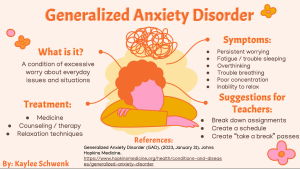
References:
Cyberbullying: Empowering against online harassment
Click on the video posted below!
References:
Binamé, C. & Prupas J. (2011). Cyberbully. ABC Family
Dupej, H. & Embry, M. (2020). Dark cloud: The high cost of cyberbullying. TELUS Wise.
Tips for Teachers: Warning Signs a Child is Being Cyberbullied or is Cyberbullying. (2021, May 21). stopbullying.gov. https://www.stopbullying.gov/cyberbullying/tips-for-teachers
Wilkey Oh, E. (2019, March 25). Teachers’ Essential Guide to Cyberbullying Prevention. Common Sense Education. https://www.commonsense.org/education/articles/teachers-essential-guide-to-cyberbullying-prevention
Unveiling the Unthinkable: School Violence Scenarios
What is School Violence?
School violence refers to acts of violence that take place within educational settings, disrupting the learning environment and adversely impacting students, schools, and the community (CDC, 2021). These acts of violence include bullying and cyberbullying, weapon use, fighting, vandalism, sexual assault, and many others. These issues also don’t only take place on school property. It can occur at a school event, to and from school, online, or on a school bus. Bringing attention to school violence is crucial for both students and teachers to protect the safety and well-being of everyone in the school community, prevention, and support within schools. By bringing attention to this issue, it will create a school environment where everyone feels safe, valued, and respected.
 https://www.istockphoto.com/illustrations/gun%5B/caption%5D
https://www.istockphoto.com/illustrations/gun%5B/caption%5D
A majority of American teens and parents are starting to share more concerns about potential school shootings. Graf (2018) stated that 57% of students express concerns about the potential occurrence of a shooting at their school. Around 29% state they are not overly worried, and 13% say they are not worried at all. Graf (2018) also stated that the levels of worry are also affecting the parents, with 63% indicating at least some level of concern regarding the potential occurrence of a shooting happening at their child’s school. Similar trends emerge concerning race and gender, with nonwhite parents expressing more concern.
School violence, specifically school shootings is becoming more of a critical issue as the years move on. According to Education Week analysis (2024), there have been 7 school shootings this year that resulted in injuries or death. Since 2018, there have been 189 shootings with 38 of them being in 2023 (Education Week, 2024).
As a future elementary school teacher, the number of school shootings increasing year by year has made me very worried and concerned. The primary concern for teachers is the safety and well-being of their students. School shootings pose a significant threat to the safety of the school with educators being responsible for ensuring a safe learning environment. Students, faculty, and everyone associated with the school community should feel safe and protected while going, not fearful of what will happen that day. This is a major concern that still shows no signs of decreasing. As future educators, we must advocate for effective policies and work together to increase prevention rates to protect ourselves, our students, and our community.
How Can We Prevent Violence In Schools?
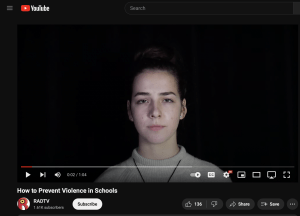 https://www.youtube.com/watch?v=E-jCgcS-1ks%5B/caption%5D
https://www.youtube.com/watch?v=E-jCgcS-1ks%5B/caption%5D
All members of the school community can play their part in ensuring we keep the school a safe space where everyone feels protected and respected. Jack Hughes, a senior at Radnor High School, entered a video montage explaining how to prevent school violence. The video explains how it impacts students, prevention, statistics, and results. To prevent school violence, members of the school should report incidents of violence to a teacher, guidance counselor, or trusted adult in the school community. This is important as you are sticking up for the person and being the voice for them. Throughout the video, the saying “Say something” is repeated over and over again. When you “say something” it promotes early intervention, prevention, safety, and empowerment. Encouraging individuals to speak up and report concerning behavior is one step closer to creating a safer school environment for all.
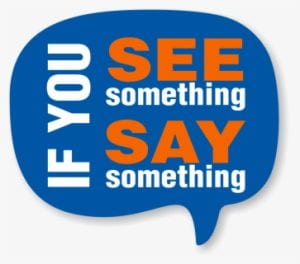 https://www.myhardhatstickers.com/if-you-see-something-say-something-hard-hat-decals/SKU-hh-0525%5B/caption%5D
https://www.myhardhatstickers.com/if-you-see-something-say-something-hard-hat-decals/SKU-hh-0525%5B/caption%5D
Bowling for Columbine:
The film Bowling for Columbine is a documentary film directed by Michael Moore. The documentary explores the causes and consequences of the 1999 Columbine High School massacre in Colorado, where two students, Eric Harris and Dylan Klebold, killed twelve students and one teacher before committing suicide. The film delves into the critical issues surrounding gun violence in schools and American culture.
Watching this documentary made me feel a mix of emotions. All of the phone calls and video surveillance made it feel like I was living in that moment with everyone else. It was scary to watch, especially the parts where the cameras caught the students with the guns and the aftermath. While some students were being interviewed after the incident, I could never imagine watching and listening to the stories they had to witness. No child should ever have to see their classmates dying or having a gun held to their head by another student.
As a future elementary school teacher, the issue of school violence is one that deeply concerns me. This documentary served as a reminder of the potential dangers and challenges that educators may face in schools and society. The safety and well-being of my students would be my top priority. No child should come to school worried, they should feel safe and protected. The events shared in the documentary highlight the devastating impact that school violence can have on students, their families, and the community.
Additionally, issues of school violence can result in an increased amount of anxiety within the school community. Schools should increase security measures such as lockdown drills and cameras which can decrease the amount of fear and anxiety within the people in the school. As a future teacher, I would strive to address these concerns and provide support to students who may be struggling by building an open and trusting relationship with all of them.
 https://www.amazon.com/Bowling-Columbine-Michael-Moore/dp/B07KRKXDZ2%5B/caption%5D
https://www.amazon.com/Bowling-Columbine-Michael-Moore/dp/B07KRKXDZ2%5B/caption%5D
References:
Fast Fact: Preventing School Violence |Violence Prevention|Injury Center|CDC. (n.d.). https://www.cdc.gov/violenceprevention/youthviolence/schoolviolence/fastfact.html?CDC_AA_refVal=https%3A%2F%2Fwww.cdc.gov%2Fviolenceprevention%2Fyouthviolence%2Fschoolviolence%2Findex.html
 https://www.pbisrewards.com/blog/improving-parent-teacher-communication/%5B/caption%5D
https://www.pbisrewards.com/blog/improving-parent-teacher-communication/%5B/caption%5D
 https://twitter.com/artteacherjoys/status/1184712453738729472%5B/caption%5D
https://twitter.com/artteacherjoys/status/1184712453738729472%5B/caption%5D
 https://onlinelearningconsortium.org/8-things-you-should-know-before-using-social-media-in-your-course/%5B/caption%5D
https://onlinelearningconsortium.org/8-things-you-should-know-before-using-social-media-in-your-course/%5B/caption%5D
 https://www.platinumseoservices.com.au/blog/pros-and-cons-of-seo/%5B/caption%5D
https://www.platinumseoservices.com.au/blog/pros-and-cons-of-seo/%5B/caption%5D
 https://topdocumentaryfilms.com/plugged-in-true-toxicity-social-media-revealed/%5B/caption%5D
https://topdocumentaryfilms.com/plugged-in-true-toxicity-social-media-revealed/%5B/caption%5D


 https://ny.pbslearningmedia.org[/caption%5D
https://ny.pbslearningmedia.org[/caption%5D
 https://www.bing.com/images/search?view=detailV2&ccid=vCyZkhDk&id=FBF6940876DE8D75564E2F55E70044A472158AC3&thid=OIF.Y78RHkrdZymHOgUWmGvdTw&mediaurl=https%3a%2f%2ftimesgo24.com%2fwp-content%2fuploads%2f2024%2f02%2fimage-305.png&cdnurl=https%3a%2f%2fth.bing.com%2fth%2fid%2fR.bc2c999210e45c228ae7f69c10c8931c%3frik%3d%26pid%3dImgRaw%26r%3d0&exph=315&expw=474&q=fast+car+tracy+chapman&simid=281807334813&FORM=IRPRST&ck=63BF111E4ADD6729873A0516986BDD4F&selectedIndex=2&itb=0&ajaxhist=0&ajaxserp=0%5B/caption%5D
https://www.bing.com/images/search?view=detailV2&ccid=vCyZkhDk&id=FBF6940876DE8D75564E2F55E70044A472158AC3&thid=OIF.Y78RHkrdZymHOgUWmGvdTw&mediaurl=https%3a%2f%2ftimesgo24.com%2fwp-content%2fuploads%2f2024%2f02%2fimage-305.png&cdnurl=https%3a%2f%2fth.bing.com%2fth%2fid%2fR.bc2c999210e45c228ae7f69c10c8931c%3frik%3d%26pid%3dImgRaw%26r%3d0&exph=315&expw=474&q=fast+car+tracy+chapman&simid=281807334813&FORM=IRPRST&ck=63BF111E4ADD6729873A0516986BDD4F&selectedIndex=2&itb=0&ajaxhist=0&ajaxserp=0%5B/caption%5D
 https://www.bing.com/images/search?view=detailV2&ccid=OceGM1wI&id=6EE40CA62F3B7D9C22D97A484D995FCE51B51650&thid=OIP.OceGM1wIy5qpx7YrtFvbTAHaHY&mediaurl=https%3a%2f%2fth.bing.com%2fth%2fid%2fR.39c786335c08cb9aa9c7b62bb45bdb4c%3frik%3dUBa1Uc5fmU1Ieg%26riu%3dhttp%253a%252f%252fprodimage.images-bn.com%252fpimages%252f9780395664155_p0_v1_s1200x630.jpg%26ehk%3dQYUVxVRBRyyVBNse%252bxEnxSLTDXTYfMXgjdsnZFFtROw%253d%26risl%3d%26pid%3dImgRaw%26r%3d0&exph=630&expw=632&q=%22Fly+Away+Home%22+by+Eve+Bunting%2c+illustrated+by+Ronald+Himler%3a&simid=608010225522135047&FORM=IRPRST&ck=4861E961B653A97610AB7765A4848001&selectedIndex=0&itb=0&ajaxhist=0&ajaxserp=0%5B/caption%5D
https://www.bing.com/images/search?view=detailV2&ccid=OceGM1wI&id=6EE40CA62F3B7D9C22D97A484D995FCE51B51650&thid=OIP.OceGM1wIy5qpx7YrtFvbTAHaHY&mediaurl=https%3a%2f%2fth.bing.com%2fth%2fid%2fR.39c786335c08cb9aa9c7b62bb45bdb4c%3frik%3dUBa1Uc5fmU1Ieg%26riu%3dhttp%253a%252f%252fprodimage.images-bn.com%252fpimages%252f9780395664155_p0_v1_s1200x630.jpg%26ehk%3dQYUVxVRBRyyVBNse%252bxEnxSLTDXTYfMXgjdsnZFFtROw%253d%26risl%3d%26pid%3dImgRaw%26r%3d0&exph=630&expw=632&q=%22Fly+Away+Home%22+by+Eve+Bunting%2c+illustrated+by+Ronald+Himler%3a&simid=608010225522135047&FORM=IRPRST&ck=4861E961B653A97610AB7765A4848001&selectedIndex=0&itb=0&ajaxhist=0&ajaxserp=0%5B/caption%5D


 https://www.istockphoto.com/illustrations/gun%5B/caption%5D
https://www.istockphoto.com/illustrations/gun%5B/caption%5D
 https://www.youtube.com/watch?v=E-jCgcS-1ks%5B/caption%5D
https://www.youtube.com/watch?v=E-jCgcS-1ks%5B/caption%5D
 https://www.myhardhatstickers.com/if-you-see-something-say-something-hard-hat-decals/SKU-hh-0525%5B/caption%5D
https://www.myhardhatstickers.com/if-you-see-something-say-something-hard-hat-decals/SKU-hh-0525%5B/caption%5D
 https://www.amazon.com/Bowling-Columbine-Michael-Moore/dp/B07KRKXDZ2%5B/caption%5D
https://www.amazon.com/Bowling-Columbine-Michael-Moore/dp/B07KRKXDZ2%5B/caption%5D